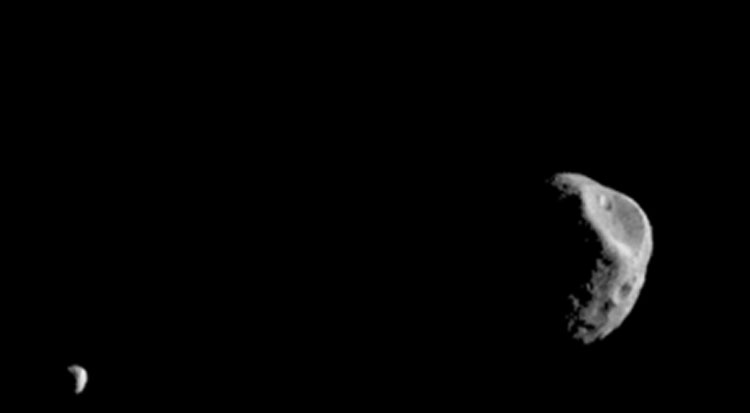Watch Moons of Mars 'Dance' in NASA Video (But There's a Trick)
Phobos and Deimos, the two moons of Mars, are rocky and odd, but they share a serene grace as they appear to dance by each other in this stunning video of NASA images. But don't be fooled: the moons aren't moving like the video suggests.
The new view of Phobos and Deimos is the work of NASA's Mars Odyssey spacecraft, which has been orbiting the Red Planet since 2002. The orbiter snapped 19 photos of the Martian moons during a 17-second time span on Feb. 19. NASA scientists then assembled the images into a short animation, which we looped into the video you see here. [See more photos of Phobos and Deimos here]
The animation shows Mars' smaller moon Deimos appear to move down and to the left, passing out of frame as the larger Phobos rises on the right. But that weird motion is really due to Odyssey's Thermal Emission Imaging System camera (known as THEMIS), and not the moons themselves, NASA officials said.

"This was the second observation of Phobos by Mars Odyssey; the first was on September 29, 2017," NASA officials wrote in an image description. "Researchers have been using THEMIS to examine Mars since early 2002, but the maneuver turning the orbiter around to point the camera at Phobos was developed only recently."
<> The views of Phobos and Deimos in the video were taken in the visible-light range of the spectrum, but Odyssey's THEMIS camera also recorded observations in the thermal-infrared wavelength range as well, NASA officials said.

Odyssey was about 3,489 miles (5,615 kilometers) from Phobos, and 12,222 miles (19,670 km) from Deimos, when it observed the two moons. Phobos is Mars' biggest moon, at about 14 miles (22 km) wide. Deimos, meanwhile, has a diameter of about 8 miles (13 km).
At 17 years and counting, Mars Odyssey is the longest-serving Mars mission of all time. NASA launched Odyssey in April 2001, with the orbiter arriving at Mars in October of that year.
Get the Space.com Newsletter
Breaking space news, the latest updates on rocket launches, skywatching events and more!
Email Tariq Malik at tmalik@space.com or follow him @tariqjmalik and Google+. Follow us @Spacedotcom, Facebook and Google+. Original article on Space.com.
Join our Space Forums to keep talking space on the latest missions, night sky and more! And if you have a news tip, correction or comment, let us know at: community@space.com.

Tariq is the Editor-in-Chief of Space.com and joined the team in 2001, first as an intern and staff writer, and later as an editor. He covers human spaceflight, exploration and space science, as well as skywatching and entertainment. He became Space.com's Managing Editor in 2009 and Editor-in-Chief in 2019. Before joining Space.com, Tariq was a staff reporter for The Los Angeles Times covering education and city beats in La Habra, Fullerton and Huntington Beach. In October 2022, Tariq received the Harry Kolcum Award for excellence in space reporting from the National Space Club Florida Committee. He is also an Eagle Scout (yes, he has the Space Exploration merit badge) and went to Space Camp four times as a kid and a fifth time as an adult. He has journalism degrees from the University of Southern California and New York University. You can find Tariq at Space.com and as the co-host to the This Week In Space podcast with space historian Rod Pyle on the TWiT network. To see his latest project, you can follow Tariq on Twitter @tariqjmalik.
